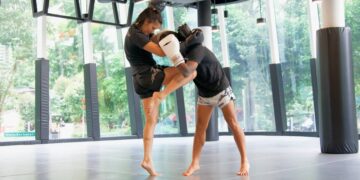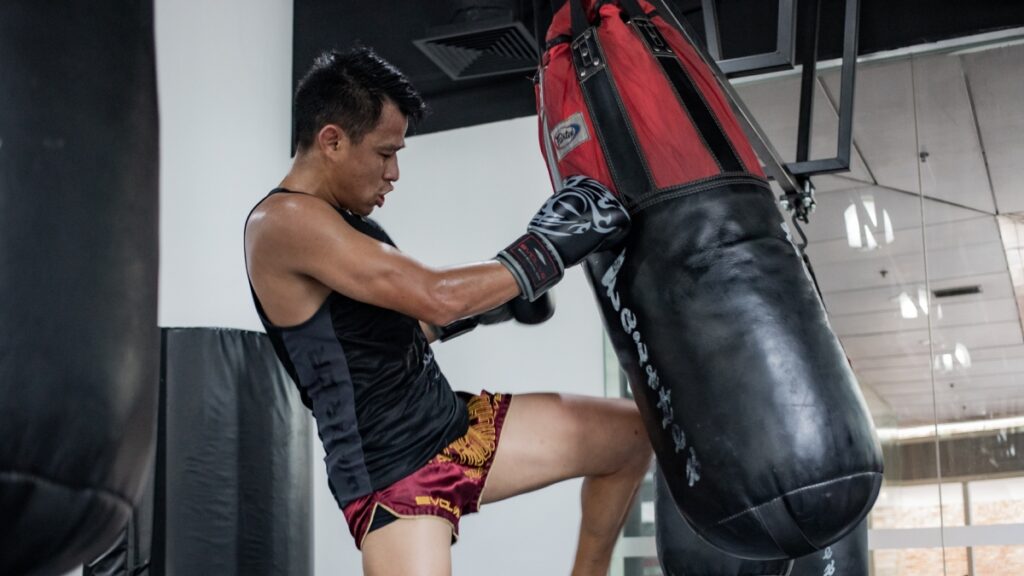While Muay Thai is undoubtedly a team sport and most of your training will be done in groups and under the watchful eye of a trained coach, there will inevitably be times when you need to train by yourself.
Self-directed training, that is skills and drills you work on without a coach, is a small but common part of a Muay Thai athlete’s fight preparation. It is also the easiest part of your training routine to get wrong. Beginning solo Muay Thai drills without the right approach and mindset is a surefire way to develop bad habits.
With this in mind, we’ve decided to create this step-by-step guide to self-directed training. In the next few paragraphs, we’ll outline the common mistakes people can make when solo training and give you some ideas on how to avoid them. Then, finally, we’ll list some of the most essential solo training drills in Muay Thai and explain how to get the most out of them.
The Issue With Self-Directed Training
The common issue with solo training is revealed in its name. It’s solo. There is no one there to correct you. So, if you happen to throw something with bad technique without realizing it then you could wire in bad habits that can be extremely difficult to break, especially if you do a lot of solo training without a chance for someone to correct it. If this happens, then you will be slowing your development as it takes more time to unlearn bad habits than it does to learn a new one from scratch.
How To Avoid Reinforcing Errors
The simple way to avoid ingraining bad technique when training solo is to make sure that you keep your drills simple. Doing too much too fast is a definite way to make little mistakes, eventually, these mistakes become big problems.
When training to improve technique on your own, it’s vital to be specific in your goals for the session. It’s going to be difficult to maintain impeccable form and composure if you are working on too many things at once. Once you have picked a particular focus for the session begin by starting slow and make sure to focus on the key points of performance in every technique you throw before you add intensity.
For example, if you are kicking, don’t throw your shots as hard and as fast as you can right away. Start slow, work on starting and finishing in the correct position, rotating your hips, and coming up onto the ball of your feet. Once you’re able to do them perfectly at a slow and relaxed tempo, gradually increase the power and speed whilst maintaining your commitment to form.
Your phone camera can be a great asset when training solo. You can use your camera to record you as you undertake solo training. This gives you the ability to gain a ‘coach’s eye view’ of your technique between rounds. You’ll get a clearer picture of your technique and what you need to improve on whilst informing you of any errors you could potentially be making before they become muscle memory.
Balance Drills On The Bag
Balance is a vital skill in Muay Thai. Without it, you can’t land effective kicks and are an easy target for any opponent looking to sweep you. Luckily, it is very easy to improve your balance working on your own with three very simple heavy bag drills. All of these drills increase in difficulty as you add power and speed to the movement, so make sure you begin slow.
1) Kick Into Knee Guard
In this drill, you are mimicking the technique that you would use if a fighter has caught your body kick, and you are trying to stop them from sweeping you. Simply throw a kick to the body and as the kick connects continue turning your hip over so that your shin is braced horizontally across the bag.
2) Kick Into Block
This technique shown by Muay Thai World Champion Kiewpayak Jitmuangnon can easily be modified for solo work on a heavy bag. Being able to land a body kick and reverse your momentum into a perfect Muay Thai block requires excellent balance and technique. After landing a body kick to the bag return your leg to a strong Muay Thai block without letting your foot touch the floor. Once you can do this perfectly, begin to repeat the movement, going directly from your block into another kick and block without pause.
3) Kick And Transition Into A Teep (Push Kick)
In this drill, you begin with a kick, followed by a second kick. The second kick transitions into a teep. Once you’ve mastered your balance and ensured your teep accuracy is precise, you can elevate the difficulty by integrating it with preceding balance drills. This involves transitioning seamlessly from a kick to a block, and ultimately to a teep, without any pauses.
Cardio And Conditioning Drills On The Heavy Bag
The following drills are staples in self-directed Muay Thai training. They can be used to build cardio and endurance when you are training alone. That being said, you will be doing yourself a disservice if you approach them with the mindset of completing them as fast as possible without focusing on technique. As with all of the other self-directed training drills, it is important to start slow and make sure that you are hitting all of your points of performance before you increase the intensity of your training.
1) Teeping The Heavy Bag
It’s not uncommon to see fighters throwing anywhere from 200-300 teeps on a heavy bag as a way to condition their legs and improve their teeps. Whether you are doing all of your teeps on one leg or alternating between the two there are some key points of performance to focus on to ensure that you are developing great technique through this drill. These include the following:
- Be Accurate: Teep the same spot on the bag every time. A great way to make sure you are working on your accuracy is to make sure that the bag doesn’t spin after your teep it. Many people will place a sticker or mark the bag with tape to give them a clear idea of where to aim their teep.
- Use Your Hips: Teeping isn’t just the art of lifting your leg and pressing it into your opponent’s stomach, most of your power comes from your hips. So, make sure to press your hips into every teep.
- Lean Back: As you extend your leg, make sure to lean your head back so you are out of range of any imaginary punches coming your way. Doing this also counterbalances your teep, so that if you miss you don’t fall forward into an awaiting counter.
2) Kneeing The Heavy bag
Once again, it is incredibly easy to ingrain bad habits if you don’t approach this tried and tested solo training drill correctly. So, whether you are doing a marathon run of 500+ knees unbroken or you are doing intervals of 20 power knees at a sprint, make sure that you are focusing on the following:
- Knee To The Body: It is natural for your knees to start to drift south of the border when you get tired, so you must be aiming for a spot on the bag in line with your belly button. Once again, using some tape to mark the correct height on the bag can be useful to make sure you are kneeing high enough.
- Kick Your Legs Back: Remember, in Muay Thai, it is only effective strikes that make an impact on the scorecards. If you are just tapping the bag with your knee, then you aren’t training good technique. Make sure to create power by kicking your leg behind you before driving your knee forward.
- Use Your Arms: You need to strengthen your arms if you want to be successful in the clinch and using your knees on the bag is a great opportunity to do this. Make sure you grab the sides of the bag around head height and make sure that you are pushing the bag away as you extend your leg behind you. Then pull it back into you as you deliver your knees.
3) Shadowboxing
Anyone who has been bitten by the Muay Thai bug won’t be able to help but break into a round of shadowboxing at random times when they are alone at home. While it is easy to get lost in the joy of moving around and throwing techniques for the fun of it, it’s important to keep technique and ringcraft in mind when you start sparring with an invisible opponent. So, next time you are shadowboxing alone, keep the following things in mind.
- Visualise: Whenever you are shadowboxing, try to imagine yourself pulling off the specific techniques and drills that you have practiced in training on an invisible opponent. Imagine how they are going to move and what signs your adversary will give to prompt you to pull off the techniques that you plan on using in the ring.
- Keep It Realistic: Don’t fall into the trap of throwing shots for the sake of it. Remember the ranges for your different weapons and only ingrain the combinations that you will use in the ring.
- Be Specific: You don’t need to shadowbox all eight of your weapons at once. You can break things down and only shadowbox your weaknesses. So, if your trainer has told you that you need to work on your footwork, don’t distract yourself with massive hand and elbow combinations, just imagine how you need to move when you are in the ring with your opponent.
Conclusion
It doesn’t matter what skill level you possess; the above drills can help you improve your Muay Thai game. There are tonnes of benefits to training alone and there are many other solo training drills that you can practice. Just remember, you will only improve through self-directed training if you remember to start slow and remain focused on technique.
You may also like:
How To Eat And Diet Like A Muay Thai Fighter
In Muay Thai, you need to have power in your kicks and knees if you want to dominate in the ring. Unlike other striking sports where the volume of shots landed plays a major role…
Muay Thai sweeps are a work of art. In the sport, few techniques require greater accuracy and timing, and seeing one executed with precision is truly captivating. Not only are sweeps beautiful to watch, but…
Muay Thai may be an ancient martial art but as a sport, it is always evolving. Every day, across every corner of the globe, athletes are pushing their bodies to the limit, trying to get…
Kicks are one of the most powerful strikes in combat sports, such as Muay Thai, and a spinning back kick is one of the most powerful kicks you can throw. The technique derives extra power…
Muay Thai aka the “Art of Eight Limbs” is a striking-based martial art from Thailand that utilizes fists, elbows, knees, and shins as weapons. It is widely viewed as the most effective striking system ever…
Everyone who’s been training Muay Thai for more than a few months knows that fighting against a southpaw fighter is a headache. Your opponent moves the wrong way, your favorite techniques fail to land cleanly,…
In the exciting world of Brazilian Jiu-Jitsu, the side control position serves as a cornerstone for domination and submission. From this pin, practitioners have excellent attacking options at their disposal, enabling them to control opponents…
Artificial intelligence (AI) is on course to revolutionize how martial artists personalize their diets to make weight for their competitions and to optimize their performances during martial arts classes. Most nutritionists measure success in terms…
Boxing is such an incredible martial art. Not only is it a great self-defense methodology, but it’s also an amazing way to get in shape. People turn to boxing to lose weight, gain lean muscle,…
Singapore’s Central Business District (CBD) is a dynamic centre of activity where commerce, culture, and coffee intertwine. Professionals buzzing between high-rise offices, tourists marvelling at the city’s impressive skyline, and locals navigating their daily routines…
The hand trap is an advanced boxing technique many boxers use at the highest level. The technique momentarily restricts one of your opponent’s arms, limiting their offensive options while you fire away. Holding on to…
One of the common concerns that are often brought up regarding vegan and vegetarian diets is that they might not provide sufficient protein. However, many experts say a well-structured vegan diet can still provide all…



































